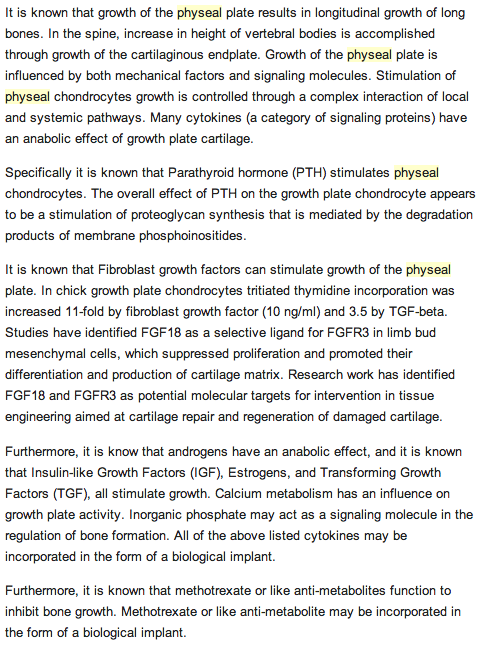New Chemicals and Cytokines For Physeal Chondrocyte Stimulation Discovered
In our most recent post on the possibility on using the chemical Parathyroid Hormone (PTH) to modulate and control the amount of growth that the vertebrate bones will go through in a developing adolescent, some new chemicals and cytokines were revealed to us which I had previously guessed has many stimulating effects on chondrocytes and the physeal layer.
The patent that we reference is entitled “Method of treating scoliosis using a biological implant (Patent #:US 8123787 B2)“. Under the section titled “Detailed Description of the Invention” the inventors write the following passage, which I clipped and pasted below. I will be going into detail to list and check the validity of the claims of each compound that they mention.
Out of all of these, it is probably the FGF18 that is the compound that I have found to be the most interesting, and that is mainly because I have never heard about this receptor or cytokine signalling factor before being associated with chondrocyte stimulation.
I remember that when it comes with FGFR3, inhibiting of that receptor is supposed to be able to treat children with achondroplasia like the chemical compounds NF449 and BMN-111 by BIomarin.
What I wanted to do is find at least 2 studies which validates the idea that FGF18 is beneficial on physeal activity.
- Fibroblast growth factor-18 stimulates chondrogenesis and cartilage repair in a rat model of injury-induced osteoarthritis.
- Treatment of cartilage disorders with fgf-18 (Patent #: EP 2054050 A2)
- AS902330 in Cartilage Injury Repair (CIR) (In ClinicalTrials.gov)
I will not be focusing that much on the other cytokines but this compound FGF18 is the one which is most interesting to me. There has been maybe just 2-3 published papers on the efficacy of intra-articular injections of FGF18 to treat osteoarthritis is so the area and possibility of the growth factor/cytokine is still potentially huge.
I suspect that FGF18 when injected into the bone under the articular cartilage may cause cartilage repair.

